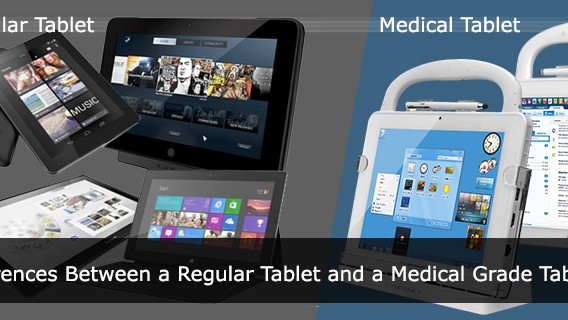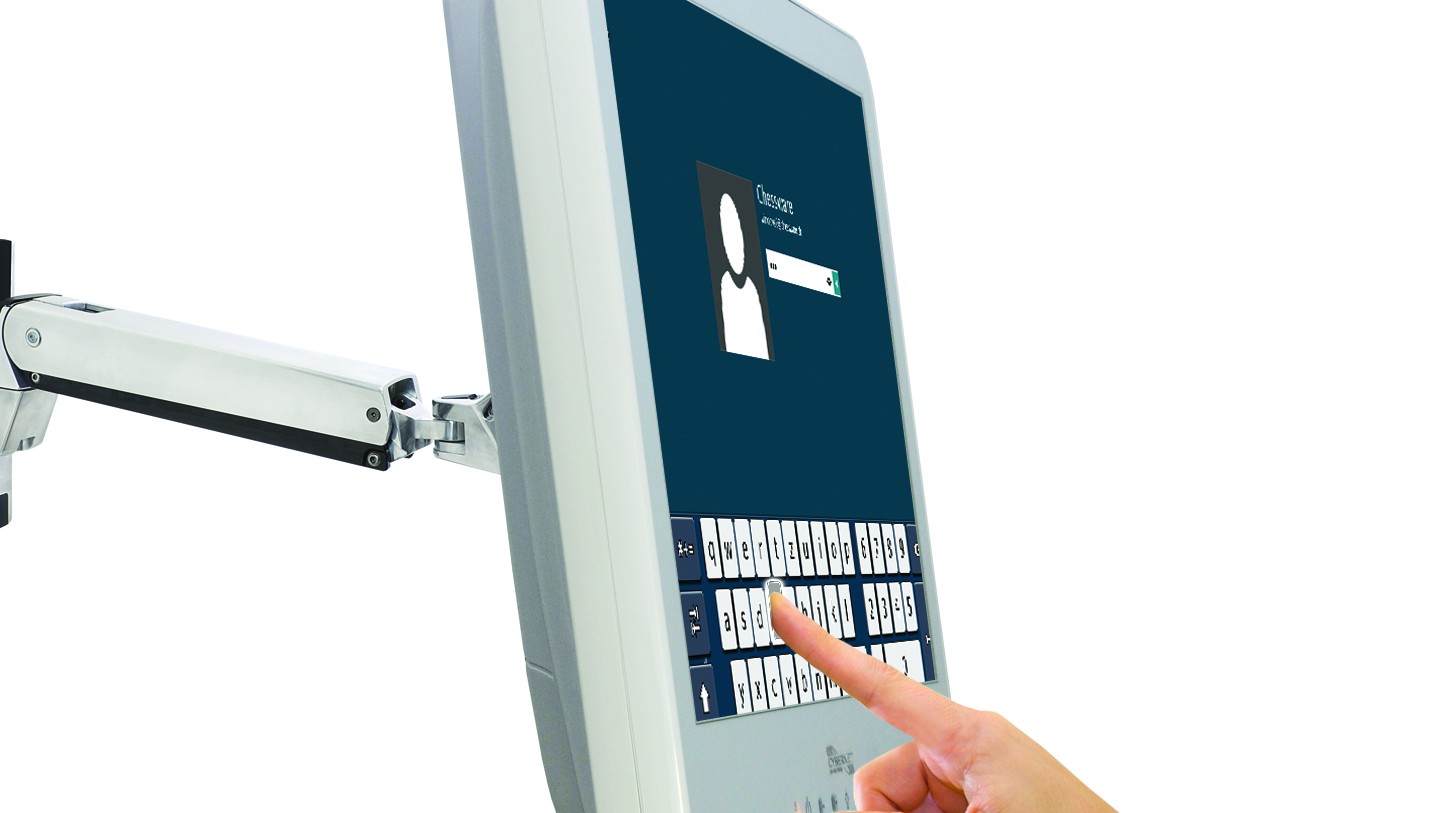Computers play a vital role in healthcare regardless of the specialty, and the importance of high-quality medical-grade monitors is just as critical. For this reason, specific requirements, features, and certifications are given for medical-grade monitors that are vastly different from typical consumer-grade monitors.
Choosing the right monitor for your application can make all the difference. When lives are at stake in the medical field, only the best will do.
Understanding Medical-Grade Monitors
Article Guide
A medical grade monitor is purpose-built to operate effectively in healthcare settings, where reliability, hygiene, and precision are paramount. Unlike typical consumer-grade monitors, medical-grade monitors are engineered to deliver consistent performance in challenging conditions.
Medical-grade monitors find their utility in a wide range of healthcare applications. They are commonly used in diagnostic imaging, surgical procedures, record-keeping, telemedicine, and more. The significance of these monitors becomes evident in scenarios where high image quality and resolution are critical, such as identifying tumors or determining the best approach for treating fractures.
Read more: Understand the Full Meaning of Medical-Grade
Key Characteristics of Medical-Grade Monitors
Medical-grade monitors are specially crafted to meet the exacting demands of healthcare settings. They excel in providing high-quality images, ensuring reliability, maintaining hygiene, and adhering to strict medical standards. This combination of features makes them indispensable tools in the healthcare industry, where precision and safety are paramount.
- High Image Quality and Resolution: Medical-grade monitors are renowned for their exceptional image quality and resolution. This is pivotal in healthcare, where accurate visualization can be a matter of life and death.
- Reliability: Medical-grade monitors are engineered to operate continuously for extended periods, sometimes without being powered off for days. This reliability is vital in healthcare settings, ensuring that the monitor performs consistently.
- Hygiene and Durability: These monitors are designed with a focus on hygiene. They are both dustproof and water-resistant, typically rated at IP65. This feature is essential as medical monitors often need to withstand rigorous cleaning routines with heavy-duty disinfectants without sustaining damage.
- Compliance with Medical Standards: A defining factor that sets medical-grade monitors apart is their compliance with medical standards. These monitors hold certifications such as UL/cUL 60601-1 and IEC 60601, which ensure their safety for use near patients and with other medical equipment in similar environments. Without such certifications, a monitor cannot be considered genuinely medical grade.
- Durability and Reliability: While durability and reliability are crucial for any monitor, they are even more critical for medical-grade monitors. These monitors boast superior build quality, undergo stringent testing, and often come with extended product warranties.
Benefits of Medical-Grade Monitors
In the healthcare environment, where patient care takes precedence, the choice of equipment can significantly impact the quality of care provided. Utilizing medical-grade monitors offers a multitude of benefits, enhancing patient care in several crucial ways.
- Precision in Visual Representation
One of the fundamental advantages of employing medical-grade monitors is their ability to deliver precise and reliable visual representations. In healthcare, where even minor details matter, the confidence in a monitor to display bright, sharp, and crisp images can make all the difference. For instance, in radiology, where the interpretation of X-rays or biopsies is routine, this level of image quality is of the utmost importance and directly influences the accuracy of diagnoses.
- Compliance With Medical Standards
One of the critical advantages that set medical-grade monitors apart is their adherence to stringent medical certification standards. Foremost among these is the IEC 60601-1 standard, which holds immense importance. This certification ensures that medical equipment, including monitors, does not emit harmful electrical discharge to patients or other connected devices.
In cases where a display is connected to essential medical equipment like heart monitors, ultrasound machines, or ventilators, the IEC 60601-1 certification becomes crucial. This certification guarantees that no electrical discharge from the monitor poses a risk to the patient’s safety and ensures the integrity of the connected equipment.
- Cost Efficiency
Cost efficiency is a critical consideration in healthcare, just as in any other industry. Medical-grade monitors can prove to be cost-effective investments for healthcare organizations. These monitors undergo rigorous product evaluation and testing, resulting in lower maintenance costs and extended lifespans compared to similar devices. This translates to significant cost savings and reduced downtime in the long run.
Regular Monitors in Healthcare
While consumer-grade monitors may suffice for certain applications at home or in standard office environments, they present notable limitations, especially when deployed in healthcare settings. Let’s explore the drawbacks associated with using regular monitors in a healthcare context.
Drawbacks of Consumer-Grade Monitors in Healthcare Environment
Let’s explore the drawbacks associated with using regular monitors in a healthcare context.
- Lack of Regulatory Compliance
Standard monitors, not purpose-built for hospital or clinical settings, often lack essential certifications such as IEC 60601-1-. This can lead to significant regulatory issues and constraints on their usage within healthcare facilities. Staff may not always fully comprehend the ramifications of these certifications, potentially exposing the hospital to substantial liabilities due to inadvertent misuses.
- Inadequate Visual Quality
Consumer-grade monitors don’t have uniform color accuracy and may not offer screens that are easily legible in brightly lit environments. Within the context of a hospital, where precise visual detail is critical for accurate diagnoses, these limitations can hinder healthcare professionals’ ability to assess conditions properly.
- Unsuitability for Continuous Operation
Although consumer-grade monitors may seem more cost-effective initially, their use in medical settings can become expensive and time-consuming in the long run. These monitors are not designed for continuous operation or frequent cleaning, as necessary in healthcare environments.
- Durability and Maintenance Challenges
In healthcare settings, maintaining strict sanitation standards is imperative. Monitors must undergo regular cleaning with heavy-duty disinfectants, often multiple times a day. Consumer-grade monitors are ill-suited to withstand this level of rigorous cleaning, leading to their gradual degradation and eventual replacement.
So while consumer-grade monitors may offer an initial cost advantage, their inadequacy in meeting regulatory standards, subpar visual quality, unsuitability for continuous operation, and challenges in maintaining sanitary conditions make them impractical and costlier choices for healthcare environments. Investing in medical-grade monitors, designed with the unique demands of healthcare in mind, is the more prudent and sustainable option in the long term.
Medical-Grade vs Regular Monitors: Key Differences
| Feature | Medical-Grade Monitors | Regular Monitors |
|---|---|---|
| Image Quality | Exceptional clarity, high resolution, color, contrast | Variable image quality, often lower resolution |
| Regulatory Compliance | Compliant with medical standards (e.g., IEC 60601-1) | Lacks medical standards certifications |
| Durability & Reliability | Designed for continuous extended use, low failure rate, withstands disinfectants | Not built for continuous operation, higher failure rate, shorter lifespan |
| Hygiene | Dustproof and water-resistant (typically IP65) | Lacks dustproof and water-resistant design |
| Purpose-Built | Designed for healthcare settings, precision and accuracy are critical | General-purpose displays not tailored for medical applications |
| Cost Efficiency | Cost-effective due to extended lifespan and lower maintenance costs | Initial cost advantage may lead to higher costs in maintenance and replacement |
When to Choose Medical-Grade Monitors
Choosing between a medical-grade and consumer-grade monitor depends on the specific needs and requirements of the environment in which the monitor will be used.
In essence, medical-grade monitors are essential in healthcare environments where image quality, patient safety, regulatory compliance, durability, hygiene, and long-term reliability are critical considerations. Medical-grade monitors are the best choice for:
- Critical Healthcare Applications (such as diagnostic imaging, surgical procedures, or patient monitoring)
- Patient Safety
- Specialized Healthcare Environments (such as radiology or operating rooms)
Consumer-grade monitors can suffice in non-critical or administrative tasks within healthcare, including administrative workstations, non-patient-facing displays, telemedicine for routine consultations, educational purposes, and entertainment/distraction in patient rooms.
In conclusion, the choice between medical-grade and consumer-grade monitors is not merely a matter of preference; it’s a decision that directly impacts patient care, regulatory compliance, and the overall efficiency of healthcare facilities. Medical-grade monitors stand as the pinnacle of excellence in healthcare imaging and diagnostics, offering unparalleled image quality, stringent safety standards, and lasting reliability.
At Cybernet, we understand the critical role that medical-grade monitors play in modern healthcare. Our state-of-the-art monitors are purpose-built to meet and exceed the demands of the healthcare environment.
Make the smart choice for your healthcare facility by choosing Cybernet’s medical-grade monitors. Contact us today or explore our range of medical-grade monitors
Differences Between a Regular Tablet and a Medical Grade Tablet
November 25, 2015
Technological advancements have changed our lives in numerous ways. A cleverly invented piece of technology that is increasing in popularity by leaps and bounds is the tablet. These devices have come into our lives,…
0 Comments3 Minutes
Medical-Grade vs Regular Monitors: Differences Explained
August 7, 2018
Computer monitors have become an integral part of our lives, not only at home and work, but in every facet of society today. You see them at the grocery store checkout line when the clerks scan your food, at the gas…
0 Comments7 Minutes
You Can't
Learn from a Pop-up
But we can deliver knowledge to your inbox!
We dive deep in the industry looking for new trends, technology, news, and updates. We're happy to share them with you.
Knowledge, News, and Industry Updates Right in Your Inbox




